10 of the best museums and galleries in Rome
Our Rome correspondent John Hooper takes the art beat of the capital - Renaissance palaces, Mussolini's cinema studio and daring contemporary galleries
• As featured in our Rome city guide
• As featured in our Rome city guide

Maxxi, the National Museum of Art from the 21st century
At least as impressive as the still-modest collection it houses is the Maxxi building itself, designed by the Anglo-Iraqi architect, Zaha Hadid. Covering more than 27,000 sq metres, Italy's first national museum dedicated entirely to contemporary art is a curving, jutting structure of glass, steel and concrete. Visitors find their way from collection to collection through a labyrinth of bridges and ramps. Opened in 2010, the Maxxi is located north of the centre, in the Flaminio neighbourhood, on the site of a former military barracks. Its permanent collection includes works by the Neapolitan painter, Francesco Clemente, and the British sculptor Anish Kapoor. It was recently enriched by the donation of 58 works from the collection of the late Milanese art dealer and historian, Claudia Gian Ferrari.
• Via Guido Reni 4A, +39 06 399 67350, fondazionemaxxi.it/en. Open Tue-Wed-Fri-Sun 11am-7pm, Thur and Sat 11am-10pm. Adults €11, concessions €8, under-14s free
• Via Guido Reni 4A, +39 06 399 67350, fondazionemaxxi.it/en. Open Tue-Wed-Fri-Sun 11am-7pm, Thur and Sat 11am-10pm. Adults €11, concessions €8, under-14s free
Macro: Museo d'Arte Contemporanea

The Macro on Via Nizza, which opened last December, is the newer and bigger of two spaces that make up Rome's municipal contemporary art museum. The other is in trendy-grungy Testaccio. Nestled among 19th-century apartment buildings, the main part of the museum was fashioned by the French architect, Odile Decqfrom a disused Peroni beer plant. Among other things, it houses an archive of the works of the postmodern painter and collagist Mario Schifano. Macro aims to be more active, daring and fun than the Maxxi: the lavatories have mirrored walls and translucent plastic sinks that flash different neon/UV colours as you use them. In the car park, you can see the remains of an ancient Roman house unearthed during the restoration.
• Via Nizza 38, Piazza Orazio Giustiniani 4, +39 06 6710 70400,macro.roma.museum. Macro open Tue-Sun 11am-10pm, Testaccio Tue-Sun 4pm-midnight. Adults €10 combined ticket, concessions €8, under-18s free
• Via Nizza 38, Piazza Orazio Giustiniani 4, +39 06 6710 70400,macro.roma.museum. Macro open Tue-Sun 11am-10pm, Testaccio Tue-Sun 4pm-midnight. Adults €10 combined ticket, concessions €8, under-18s free
Palazzo Altemps
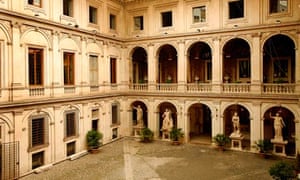
Just across from the Piazza Navona, this Renaissance palace acquired its unlikely name when it was bought by an Austrian-born cardinal in the 16th century. Taken over by the state in 1982 and not opened as a museum until 1997, it remains one of the capital's best-kept secrets. Inside is an entrancing collection of classical sculptures. They include the so-called Ludovisi Ares, a Roman copy of a 4th-century BCE Greek original, and the Ludovisi Gaul, part of the same group as the better-known Dying Gaul in the Capitoline Museums. But for sheer technical virtuosity the most astonishing exhibit is a 3rd-century sarcophagus, carved from a single block of stone, showing the Romans fighting the Ostrogoths. From the same Renaissance collection as the others, it is known as the Grande Ludovisi.
• Piazza di Sant'Apollinare 48, +39 06 399 67600,archeorm.arti.beniculturali.it/en. Open Tue-Sun 9am-7.45pm. Adults €7, concessions €3.50, free for EU citizens ages 18 to 24 and under-17s
• Piazza di Sant'Apollinare 48, +39 06 399 67600,archeorm.arti.beniculturali.it/en. Open Tue-Sun 9am-7.45pm. Adults €7, concessions €3.50, free for EU citizens ages 18 to 24 and under-17s
CineCittà Studios
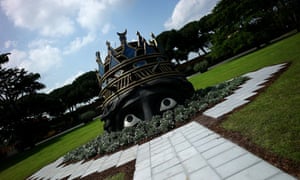
Mussolini founded Cinecittà because of his belief in the power of cinema. The studio and set complex, on the road that leads from central Rome to Ciampino airport, was bombed by the Allies in the second world war before rising to global fame in the 1950s when it was used to make the first in a string of budget-busting classical epics that included Ben-Hur and Cleopatra. CineCittà was also where Federico Fellini shot most of his films. The 40-hectare site is still claimed to be continental Europe's largest film and TV production facility. But its heyday has long gone. Among the few internationally distributed movies to be shot there in recent years was Martin Scorsese's Gangs of New York. Guided tours are available for groups of at least 20 people.
• Via Tuscolana 1055, +39 06 583 34360, cinecittastudios.it. Tours must be booked in advance by calling Mon-Fri 9am-1pm, 2pm-6pm
• Via Tuscolana 1055, +39 06 583 34360, cinecittastudios.it. Tours must be booked in advance by calling Mon-Fri 9am-1pm, 2pm-6pm
Auditorium Parco della Musica オーディトリアム音楽公園
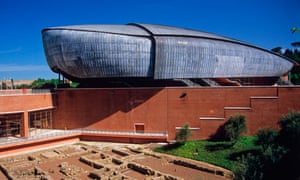
Along with the Maxxi and Macro, the Auditorium is the tangible embodiment of Rome's recent cultural renaissance. The architect Renzo Piano called his building a "factory of culture". The three concert halls, which stage not only concerts but also ballet and theatre productions, each hold between 700 and 2,800 people. The imposing foyer, which links them, is an exhibition space. In addition, there is the Cavea, an open-air theatre reminiscent of a classical amphitheatre; an art gallery, and an archaeological museum that displays artefacts found during the construction including an oil press from the 6th century BC. Guided tours are available, but note that an English-language tour (tickets €9) must be booked in advance.
• Viale Pietro de Coubertin 30, +39 06 802 41281, auditorium.com
• Viale Pietro de Coubertin 30, +39 06 802 41281, auditorium.com
Santa Maria in Trastevere

The Basilica of Our Lady is among Rome's oldest places of worship, and the one that perhaps gives the most vivid impression of a grand medieval church. It dates from around 340 AD and is thought to been the first church in Rome dedicated to Mary. In the nave are two rows of columns – 22 in all – that were taken from ancient Roman sites. The basilica was rebuilt in the 12th century by Pope Innocent II and, at the end of the 13th century, Pietro Cavallini embellished the apse with six mosaic panels of scenes from the life of Mary. Together with a gilded octagonal ceiling painting by the Baroque master Domenichino, they give the basilica a memorable glow.
• Piazza Santa Maria in Trastevere, +39 06 581 4802
• Piazza Santa Maria in Trastevere, +39 06 581 4802
Museo Nazionale dell'Alto Medioevo
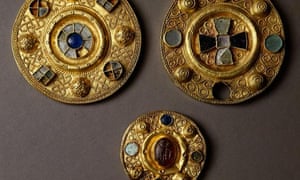
Looking for traces of the "dark ages", perhaps the last place you would start is the EUR district, built as a showcase for Fascist architecture. Yet it is there, in a less visited museum, that you can gaze on evidence that the period that followed the fall of the western empire was not as dark as is often thought: finely decorated weapons; extraordinarily intricate tapestries; glamorous earrings and necklaces. Other exhibits include an ancient metal dog chain. But the most stunning dates from late antiquity: an entire hall, taken from an aristocratic villa in Ostia, adorned with designs created using a technique known as opus sectile in which coloured marble is cut and inlaid. The most spectacular show tigers and lions catching prey.
• Viale Lincoln 3, +39 06 542 28199, archeoroma.beniculturali.it. Open Tue-Sun 9am-2pm. Adults €2, concessions €1
• Viale Lincoln 3, +39 06 542 28199, archeoroma.beniculturali.it. Open Tue-Sun 9am-2pm. Adults €2, concessions €1
Sant'Ignazio
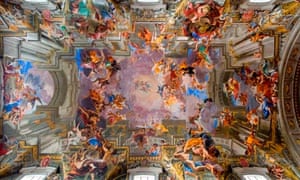
The church of illusions. It was built between 1626 and 1650 and dedicated to Ignatius of Loyola. The first giant trick is Andrea Pozzo's trompe l'oeil ceiling fresco which uses foreshortening to create an astoundingly realistic vision of the founder of the Society of Jesus soaring towards paradise to be welcomed by Christ (no, the Jesuits never were modest). A disk in the floor marks the ideal spot from which to experience the illusion. Further down the nave, another marker signals the best vantage point for a second bit of trickery. The Jesuits ran out of cash for the dome, so in 1685 Pozzo supplied them with a canvas depiction of what it might have looked like. Destroyed in 1891, the canvas was subsequently replaced.
• Via del Caravita, 8A. Open daily, 7.30am-12.30pm, 3pm-7pm
• Via del Caravita, 8A. Open daily, 7.30am-12.30pm, 3pm-7pm
Ostia Antica

Visitors to Rome who try packing in a trip to Pompeii often leave disappointed by the neglect and disorganisation they find there. Ostia Antica, less than 30km from Rome and reachable by train, offers an altogether more civilised (and arguably more instructive) experience. This, after all, was the port city of the capital of Europe's greatest empire. Scattered among the umbrella pines that now dot the site are a splendid amphitheatre which is still used for concerts, and the remains of schools, baths, temples and latrines, as well as Europe's oldest synagogue. Ostia Antica also boasts some unusually well-preserved mosaics and frescoes.
• Via dei Romagnoli 717, ostia-antica.org. Open Tue-Sun 8.30am to 7.30pm. Adults €6.50, 18-25s €3.25, over 64s and under-18s free
• Via dei Romagnoli 717, ostia-antica.org. Open Tue-Sun 8.30am to 7.30pm. Adults €6.50, 18-25s €3.25, over 64s and under-18s free
Galleria Lorcan O'Neill
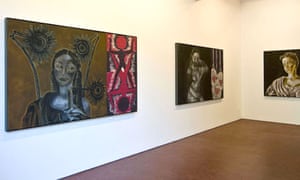
For those who yearn for a reminder of Hackney in the middle of Rome. If there was one event that confirmed the Eternal City was ready to be part of the contemporary world, then it was the opening in 2003 of this gallery in a Trastevere backstreet. The lanky O'Neill, who had been a friend to many of the YBAs, launched himself into Rome almost five years ahead of the legendary Larry Gagosian, who has a gallery at Via Francesco Crispi 16. O'Neill has used his Britart connections to put on exhibitions by Tracey Emin, Sam Taylor-Wood and Rachel Whiteread. He has also shown venerable non-Brits including Anselm Kiefer and provided a space for talented young Italians like Luigi Ontani and Pietro Ruffo.
• Via degli Orti d'Alibert 1E, +39 06 688 92980, lorcanoneill.com. Open Mon-Fri 12pm-8pm, Sat 2pm-8pm
• Via degli Orti d'Alibert 1E, +39 06 688 92980, lorcanoneill.com. Open Mon-Fri 12pm-8pm, Sat 2pm-8pm
沒有留言:
張貼留言